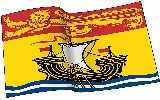|
New Brunswick
New Brunswick is the biggest of the three Maritime Provinces located in Eastern Canada. It is roughly rectangular in shape; it is approximately 242 kilometres from West to East and 322 kilometres from North to South. It covers a total area of 73,440 square kilometers. The Province borders Quebecs Gaspe peninsular to the North and part of the Southern border is connected by a narrow strip of land to the province of Nova Scotia. The Gulf of Saint Lawrence and Northumberland Strait are on the Eastern side which is entirely coastal and the Confederation bridge connects New Brunswick to the Province of Prince Edward Island. The state of Maine, USA makes up the Western boundary. The Province is in the Atlantic Time Zone which is Greenwich Meantime -4 hours. Between the months of April and October Daylight Saving is in effect and the difference is GMT -3 hours. There is a population of 729,498 people (2001) with 33 percent of them French speaking. They are the descendants of the Acadians that settled there in the 1700's. New Brunswick is the only official bilingual Province of Canada. The Provincial capital is
Fredericton
but the largest and oldest city is
Saint John .
The city of
Moncton
is located in the southeast and has been made the effective capital of modern Acadia. Other New Brunswick cities include
Bathurst,
Edmundston,
Campbellton
and
Dieppe.
The Province is split from North to South by the St. John River and has some beautiful Provincial and National Parks to explore. These have a number of rivers and lakes which are popular with white water rafters, anglers and other water enthusiasts. The landscapes vary from fairly flat areas in the eastern part of the Province to mountain peaks in the North. The terrain in the south is rugged, whereas the interior if covered in forest. January is generally the coldest month of the year with an average temperature of -8 degrees Celsius on the coast; in July the average temperature is 17 degrees Celsius. The interior of the Province has colder winters and warmer summers by a few degrees. Precipitation is normally higher in the Southern part of the Province, receiving an average of 56 inches annually. This is more or less evenly divided between the cooler and warmer seasons, Northern New Brunswick normally receives about 40 inches a year, most of it during the winter as snow. The Provincial Government of New Brunswick is now led by Premier Shawn Graham who is the leader of the Liberal Party of New Brunswick and won the September 2006 election. The Province is responsible for administering the Healthcare System which provides a basic care system for the New Brunswick residents. The Education System and the Driving Regulations are also regulated by the Province and have differences from other parts of Canada. New Brunswick has a Harmonized Sales Tax (HST) of 14 per cent. This is composed of both the Federal GST 6% and the Provincial sales tax 8% and is applied to the retail sale or rental of most goods and certain services in the Province. Residents are subject to Provincial and Federal Taxation. New Brunswick is actively seeking new residents and has a dedicated Provincial Nominee Program for both Business people and skilled workers with a profile of high demand jobs. The Provincial Government has a very informative Brochure about immigration to the Province which is packed with great content. Also, be sure to acquaint yourself with the Provincial Employment Standards which describes your rights and obligations as an employee, the minimum wage system and great links to the health and safety regulations.
|




